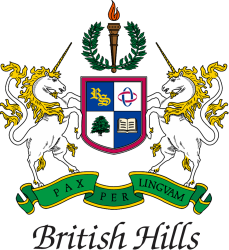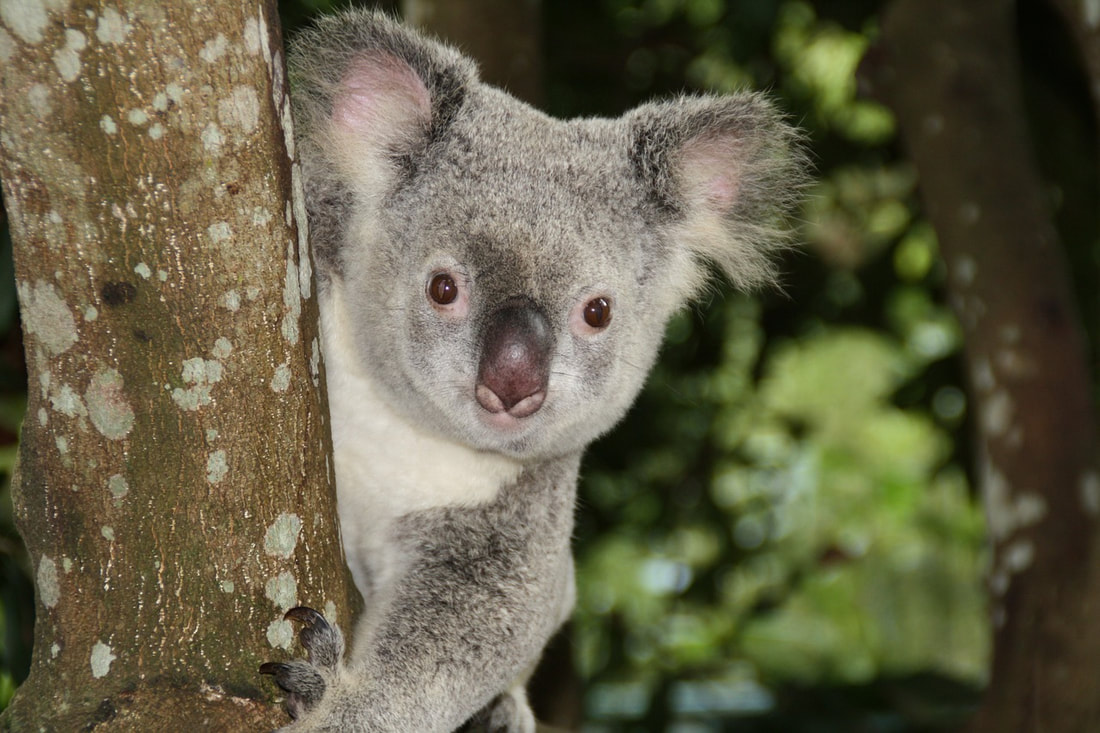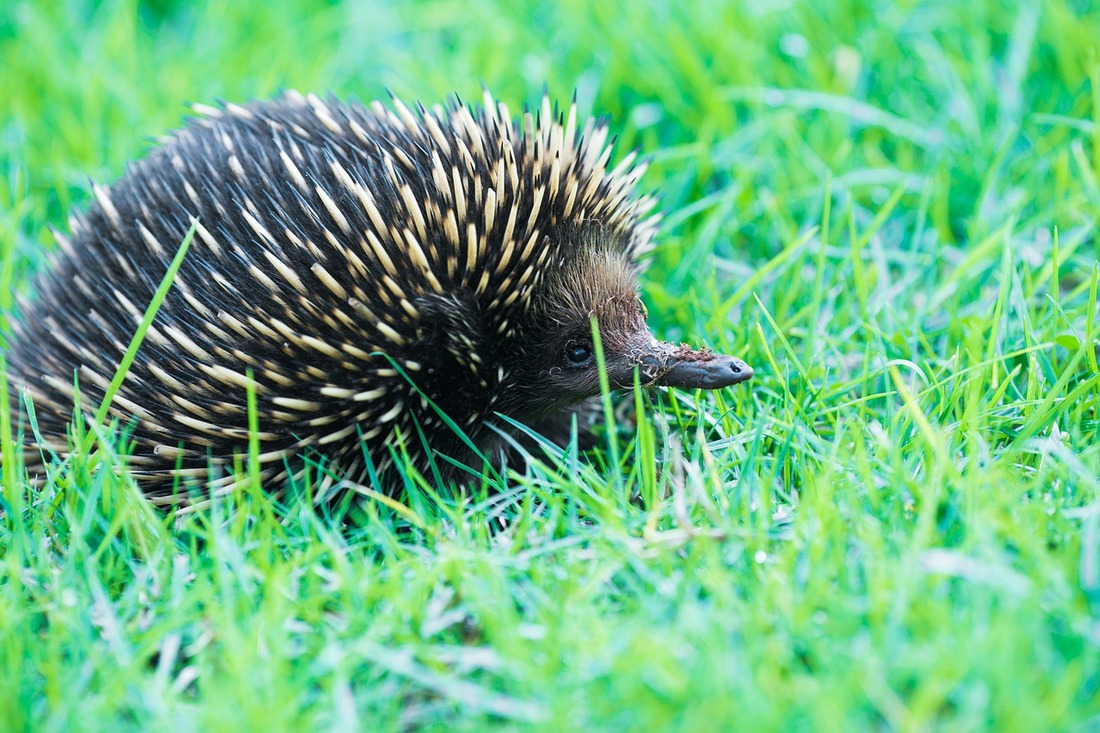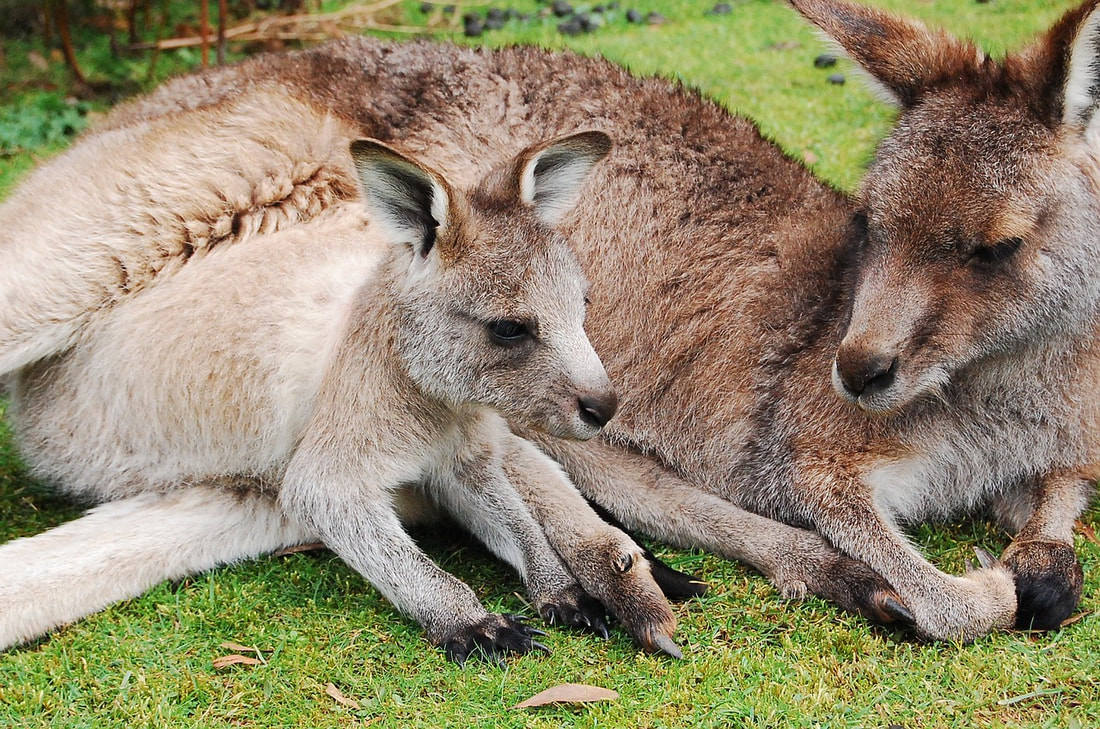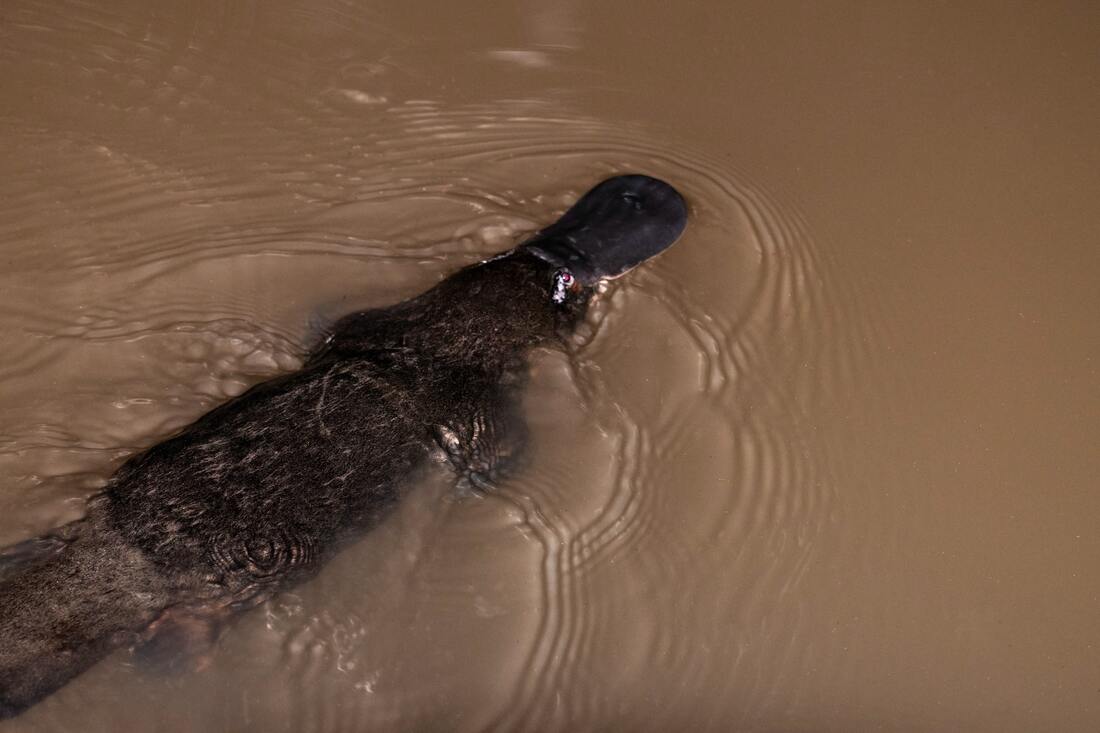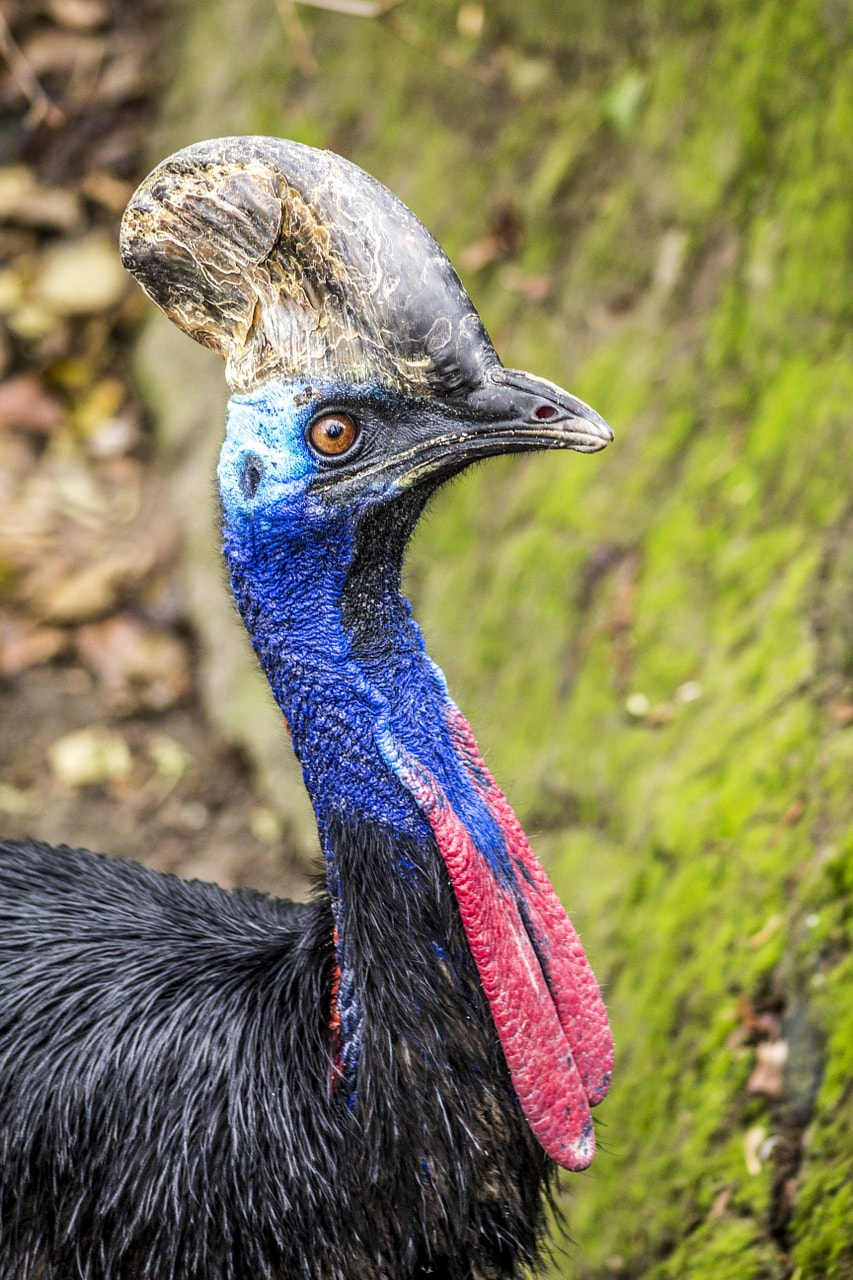Australia: Wildlife
How much do you know about the unique wildlife of Australia? Find out here, and test yourself with our quizzes!
|
The Kangaroo
The kangaroo is the symbol of Australia. A kangaroo is a large animal with 2 long, strong back legs, and a long tail. Kangaroos walk on their back legs by jumping, and they can jump long distances - up to 9 metres! Kangaroos are a type of marsupial. A marsupial is a mammal that has a pouch on their body. Female kangaroos have a pouch on the front of their belly. New-born baby kangaroos, called Joeys, are kept in this pouch after they are born, and live in the pouch until they are 10 months old. A kangaroo can be up to 2 metres tall, and live for 23 years. The fastest kangaroos can run at 48 kilometers per hour! They are herbivores, eating mainly grass. Did you know? A group of kangaroos is called a mob. The Duck-Billed Platypus
The duck-billed platypus is an unusual animal found in East Australia and Tasmania. A rare animal, they are one of only two mammals that lay eggs (the second is the echidna). All other mammals give birth to live young. Platypuses have long bodies covered in thick brown fur, with a wide, flat tail. Their most famous feature, however, is their "bill." This is the long, soft jaw at the front of their head, which looks like a duck's bill. Platypuses use this bill to find food, digging through the river bed to eat insect larvae, shrimp, and other small animals. The bill is also special because platypuses use it for electroreception. This means that platypus find food by detecting the electricity of living creatures! In fact, when a platypus swims to find food, it closes it's eyes, ears, and nose, and is completely blind - except for this "6th sense," electricity. Did you know? Male Platypuses have a venom that can hurt humans if you're not careful! The Cassowary
The cassowary is a flightless bird found in north-eastern Australia and New Guinea. The cassowary is the third largest bird in the world, after the emu and ostrich. However, the cassowary is often called the most dangerous bird in the world. Cassowaries are shy creatures that usually live alone deep in forests. They cannot fly, but can run at up to 50 km/h and jump up to 2 metres high! They eat mainly fruit, though sometimes eat small animals and insects. Cassowaries can be up to 2 metres tall, and weigh up to 58 kg. Most, however, are a little shorter and lighter than this, though still large. The females are usually brightly coloured, and all cassowary have a casque on their head that grows bigger as they get older. Famously, cassowary have three toes on each foot, each with sharp claws. The centre claw, though, is very long and sharp - like a knife. This means that a cassowary's kick can injure or even kill large animals, including humans. However, as said before, cassowary in the wild are very shy, and difficult to find. Problems most often happen when people give food to cassowary, encouraging them to approach other humans for food. In fact, we know little about the cassowary's life and habits in the wild. They have, however, been kept as pets, can be seen in tourist parks, and sometimes were semi-domesticated by the Maring people of New Guinea. Just remember that they are wild animals, and can be dangerous! Did you know? Male cassowaries raise their children. Female cassowaries abandon their eggs after laying them. |
The Koala The koala is, like the kangaroo, a marsupial. It is not a bear! Koalas are famously cute, with big furry ears, large heads, and a big black nose. They are covered in grey fur, and have strong legs and arms for climbing trees. Most koalas are about 60cm to 85 cm tall, and weigh between 4 to 18 kilograms. Just like a kangaroo, a baby koala is called a Joey. They live in the mother's pouch for about 6 months, then are carried on their mother's back for another 6 months. Koalas eat only eucalyptus leaves. Eucalyptus leaves are poisonous to other animals, but koala have a special bacteria in their stomach that helps them digest them. Did you know? Koalas sleep for about 18 hours every day! The Echidna
The echidna is a cute but spiky animal with a shy personality. They are one of only two mammals that lay eggs (the other is the platypus). They can be found in both Australia and New Guinea. Echidnas eat ants and small insects, They have no teeth, so instead crush their food between their tongue and the top of their long mouth. They can eat up to 40,000 insects every day! Echidnas live in forests and woodland, and are not aggressive. In fact, when they are frightened they curl up into a ball. They are also very slow, and can only walk at about 2 km/h. Did you know? A baby echidna is called a puggle! |
Read the information above and find the answers to the questions below!
Question 1:
How far can kangaroos jump?
Question 2:
What is a marsupial?
Question 3:
How much do koalas weigh?
Question 4:
What do koalas eat?
Question 5:
How long do koalas sleep?
Question 6:
What is the platypuses "bill"?
Question 7:
How do platypuses find their food?
Question 8:
What do echidna eat?
Question 9:
What is the name of a baby echidna?
Question 10:
Where do cassowaries live?
How far can kangaroos jump?
Question 2:
What is a marsupial?
Question 3:
How much do koalas weigh?
Question 4:
What do koalas eat?
Question 5:
How long do koalas sleep?
Question 6:
What is the platypuses "bill"?
Question 7:
How do platypuses find their food?
Question 8:
What do echidna eat?
Question 9:
What is the name of a baby echidna?
Question 10:
Where do cassowaries live?
Answers:
When you are ready, check your answers below
Question 1:
How far can kangaroos jump? Up to 9 metres!
Question 2:
What is a marsupial? A mammal that has a pouch on their body
Question 3:
How much do koalas weigh?
Question 4:
What do koalas eat? Between 4 to 18 kilograms
Question 5:
How long do koalas sleep? Up to 18 hours every day
Question 6:
What is the platypuses "bill"? The long, soft jaw at the front of their head
Question 7:
How do platypuses find their food? Electroreception
Question 8:
What do echidna eat? Ants and small insects
Question 9:
What is the name of a baby echidna? A puggle
Question 10:
Where do cassowaries live? In deep forests in north-eastern Australia and New Guinea
Question 1:
How far can kangaroos jump? Up to 9 metres!
Question 2:
What is a marsupial? A mammal that has a pouch on their body
Question 3:
How much do koalas weigh?
Question 4:
What do koalas eat? Between 4 to 18 kilograms
Question 5:
How long do koalas sleep? Up to 18 hours every day
Question 6:
What is the platypuses "bill"? The long, soft jaw at the front of their head
Question 7:
How do platypuses find their food? Electroreception
Question 8:
What do echidna eat? Ants and small insects
Question 9:
What is the name of a baby echidna? A puggle
Question 10:
Where do cassowaries live? In deep forests in north-eastern Australia and New Guinea
